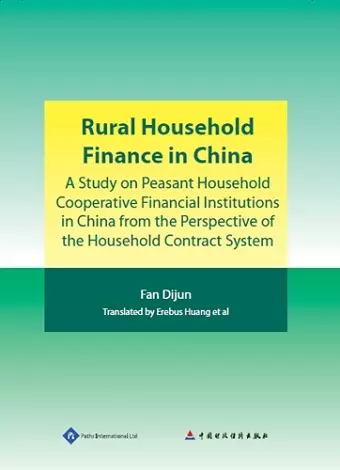Rural Household Finance in China
A Study on Peasant Household Cooperative Financial Institutions in China from the Perspective of the Household Contract System
Format:Hardback
Publisher:Paths Publishing Group
Published:30th Jan '16
Currently unavailable, and unfortunately no date known when it will be back

This book analyses the financial and rural economic reform of China. Since China started the “revolution” of the rural economy in 1978 a series of reforms has been implemented in the area of rural finance focusing on institutional changes. Looking back on these “historical changes"", we can find that there is still a long way to go. China's Central Government has put forward a new concept in the rural financial system.
In this book, with cases from Fengyang County and Anhui Province, the birthplace of Chinese rural reform, the author tries to study how to set up a modern rural financial system under the framework of incentive compatible mechanism theory, which was advanced by Nobel prize winners L. Hurwicz, Myeson and Maskin.
This book summarizes the reform of China’s rural economics and the function of financial cooperation within this policy.
Few scholars have studied this subject thoroughly. As rural financial cooperation becomes the hot spot of China’s economic and finance reform, this book is both useful and unique.
This book contains nine chapters. Chapter 1 is an introduction in which the central issue has been put forward and a survey has been made on the literature of rural finance in China and abroad. It has outlined the framework and contents and introduced the research methodology and possible innovations. And it has also proposed the direction and major issues for further research. Chapter 2 illustrates the main theories on which this research is based, including peasant economy theory and the incentive compatibility theory. Chapter 3 analyses rural households’ financial needs under the Household Contract Responsibility System and investigates rural households’ economic behaviors, saving behaviors and lending behaviors, as well as their demand constraint. By analyzing the cause and goal of the exogenous financial institutional arrangements, and also the performance of its institutional supply, chapter 4 reveals the incentive incompatibility of rural exogenous financial institutions. Chapter 5 looks at the evolution of the rural endogenous financial institution and reveals the causes of its repression in the state’s preference of financial institution from a historical perspective. Based on the incentive compatible mechanism, chapter 6 puts forward two models of rural household cooperative financial institution, namely, peasant credit cooperative and federation of rural credit cooperatives....
ISBN: 9781844644391
Dimensions: 251mm x 175mm x 25mm
Weight: 633g
300 pages